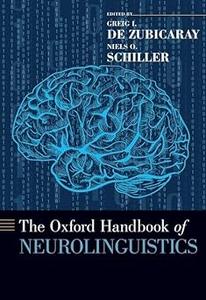牛津神经语言学手册(EPUB)

Neurolinguistics is a young and highly interdisciplinary field, with influences from psycholinguistics, psychology, aphasiology, and (cognitive) neuroscience, as well as other fields. Neurolinguistics, like psycholinguistics, covers aspects of language processing; but unlike psycholinguistics, it draws on data from patients with damage to language processing capacities, or the use of modern neuroimaging technologies such as fMRI, TMS, or both. The burgeoning interest in neurolinguistics reflects that an understanding of the neural bases of this data can inform more biologically plausible models of the human capacity for language.
The Oxford Handbook of Neurolinguistics provides concise overviews of this rapidly-growing field, and engages a broad audience with an interest in the neurobiology of language. The chapters do not attempt to provide exhaustive coverage, but rather present discussions of prominent questions posed by given topics. The volume opens with essential methodological chapters: Section I, Methods, covers the key techniques and technologies used to study the neurobiology of language today, with chapters structured along the basic divisions of the field. Section II addresses the neurobiology of language acquisition during healthy development and in response to challenges presented by congenital and acquired conditions. Section III covers the many facets of our articulate brain, or speech-language pathology, and the capacity for language production-written, spoken, and signed. Questions regarding how the brain comprehends meaning, including emotions at word and discourse levels, are addressed in Section IV. Finally, Section V reaches into broader territory, characterizing and contextualizing the neurobiology of language with respect to more fundamental neuroanatomical mechanisms and general cognitive domains.
神经语言学是一个年轻的且高度跨学科的领域,受到了心理语言学、心理学、失语症学以及(认知)神经科学的影响,以及其他领域的影响。与心理语言学一样,神经语言学涵盖语言处理方面的内容;但它不同于心理语言学之处在于,它利用了患者在语言处理能力受损或因先天和后天疾病而使用现代神经成像技术,如fMRI、TMS或两者结合的数据。 对神经语言学的兴趣迅速增长反映了理解这些数据的神经系统基础可以促进人类语言能力更生物现实模型的理解。 《神经语言学指南》提供了这个快速发展的领域的简要概述,并吸引了一个对语言神经生物学感兴趣的广泛受众。章节没有试图提供详尽的覆盖,而是提出了给定话题所提出的主要问题的讨论。该卷以基本方法为开篇:第I部分“方法”涵盖了目前用于研究语言神经生物学的关键技术与设备,章节按领域的基本划分结构组织起来。第二部分探讨了在正常发育和面对先天性和后天性疾病挑战的语言学习中神经系统生物学的问题。第三部分涵盖了许多方面的人类明智大脑或言语-语言病理学以及语言表达能力:书面、口头和手势表达的能力。第IV节涉及如何理解意义,包括词和会话层次上的情感问题。最后,第五部分涉足更广泛的领域,对语言的神经生物学与更根本的神经系统机制和一般认知领域进行描述和背景化。
本站不对文件进行储存,仅提供文件链接,请自行下载,本站不对文件内容负责,请自行判断文件是否安全,如发现文件有侵权行为,请联系管理员删除。
Wireless Communications for Power Substations: RF Characterization and Modeling
Projective Geometry: Solved Problems and Theory Review (True PDF,EPUB)
Kingship and Government in Pre-Conquest England c.500–1066
Numerical Algorithms with C
Mathematical Modelling Skills
The Art of Encouragement: How to Lead Teams, Spread Love, and Serve from the Heart (True PDF)
Principles of Cybersecurity
React in Depth (True/Retail EPUB)
The Complete Obsolete Guide to Generative AI (True/Retail EPUB)
IT-Forensik: Ein Grundkurs